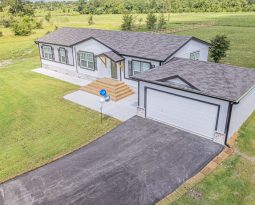Iowa Manufactured Homes Stand Up to “ Inland Hurricane ”
(The following contains excerpts from a press release – (SEND2PRESS NEWSWIRE) – provided by the Iowa Manufactured Housing Association)
One thing Iowans are familiar with is wild weather, says the Iowa Manufactured Homes Association (IMHA). Positioned in the heart of the midwest, Iowa’s weather ranges from extreme cold and snow to temperatures in the triple digits. And let’s not forget tornadoes. Iowans see virtually everything mother nature can throw, but on August 10, 2020, the state was in for a record-setting weather incident.
What has been compared to an “Inland Hurricane,” a ferocious storm called a “derecho” swept across the state with winds equal to a Category 2 hurricane, taking down 100-year-old oak trees, stripping homes of roofs, destroying business complexes, and more. But through it all, Iowa’s manufactured homes, generally perceived as an easy target for wind and storm damage, stood up to the derecho.
“We’re blessed, to say the least,” said Troy Hames, General Manager and VP of Sales for Hames Homes. “But honestly, we’re not surprised.”
The city of Cedar City, where Hames manages three manufactured home developments totaling over 900 units, seemed to suffer the worst from Iowa’s derecho. Striking an area with a population of just over 130,000, the damage was overwhelming. But Hames communities, along with other manufactured home communities throughout the state, saw comparatively little damage, limited to exterior post-production accessories, such as awnings, sheds, garages, etc.
Manufactured Home Storm And Wind Safety: “These Are Not Your Grandfather’s Mobile Homes”
Undoubtedly, there are potential homebuyers who may be somewhat reluctant to become a manufactured homeowner because of concerns regarding wind and storm safety in tornado and hurricane (and/or “derecho”) prone areas of the country and will have vivid images of news coverage following these storm and wind events with sensationalized depictions of “mobile homes” damaged or destroyed by these wind storm events.
What Troy Hames undoubtedly knew when he stated “we’re not surprised” by the minimal damage to today’s manufactured homes, was that new manufactured homes are built with regulations that have little in common with wind and storm safety of “mobile homes” of the past. “These are not your grandfather’s mobile homes,” said Hames.
What most don’t know is that the advancements in manufactured home building technology and federal regulations specific to manufactured homes have contributed to a well-documented wind safety record.
Wind safety is one of the most important requirements of the HUD Code regulations implemented in 1976, amended in 1980 and again in 1994, requiring manufacturers to comply with home building standards in pre-designated storm susceptible regions of the country indicated on the HUD Wind Zone Map of the U.S.A.
Required Ground Anchoring Key To Resisting Wind Forces
Many people who live in tornado or hurricane-prone regions of the country reside in mobile homes or manufactured homes. It’s no secret that older pre-HUD mobile homes do not fare well in these weather events. Contrary to popular beliefs, however, it’s not the building structure itself, rather how it is anchored.
Like all neighborhoods, manufactured home and mobile home communities are not monolithic. Some are sturdy homes built and installed to withstand wind forces equal to a site-built home, while older “mobile homes” are at risk if the homes are not properly anchored. Mobile homes built before HUD regulations in 1976, and enhanced in 1994, that have not been retrofitted to comply with strapping (tie-downs) and anchoring codes are especially vulnerable to wind events such as tornadoes, hurricanes, and “Derechos.”
A study by Dr. K.R. Grosskopf at the University of Florida found that not one manufactured home built after the 1994 HUD Code changes was destroyed or seriously damaged by four hurricanes that struck Florida in 2004. The same phenomenon occurred during Hurricane Katrina, with newer manufactured homes performing beyond expectations.
In another observation: “What we found in mobile homes where fatalities occur is that the home’s superstructure …itself is good,” said Steven Strader, an atmospheric scientist at Villanova University specializing in severe weather risk mitigation. “It’s as good as a single-family home.”
More information about the Iowa Manufactured Housing Association (IMHA) can be found at https://iamha.org.







